Why Worry About Security Measures for Raspberry Pi in IoT Applications?
Much like fortifying a castle against evolving threats, you can’t afford to ignore the security of your Raspberry Pi in IoT applications. Attackers often seek vulnerabilities in low-cost hardware, so a basic setup just won’t cut it. With cyber risks on the rise, you need strategies that address everything from hardware tampering to data interception. If you want your deployments to stay protected and compliant, there are critical security measures for Raspberry Pi in IoT that you shouldn’t overlook.
Key Takeaways
- Enable secure boot and verified firmware loading to prevent unauthorized modifications on the Raspberry Pi.
- Segment IoT devices with VLANs and configure firewalls to isolate Raspberry Pi systems and restrict lateral network movement.
- Use end-to-end encryption protocols (TLS, SSH, VPN) for secure data transmission and remote access.
- Regularly update Raspberry Pi devices with patches and disable unnecessary services to minimize vulnerabilities.
- Implement device authentication with strong keys or certificates and enable real-time security monitoring and logging.
Hardware Security Enhancements for Raspberry Pi
When deploying Raspberry Pi devices in IoT environments, you face sophisticated risks that demand hardware-level defenses. Secure element integration—such as MicroChip’s ATECC508/ATECC608 family—powers robust cryptographic functions, anchoring device identities and securing key management in an isolated environment. By employing a layered security approach, organizations can create multiple barriers that effectively slow down or deter attackers, ensuring that breaches at one layer do not automatically compromise the entire system.
Adopting a dual secure-processor architecture separates interface management from critical security operations, which strengthens your hardware root of trust. Physical tamper detection features—common in advanced HSM modules—can activate a self-destruct mechanism to protect sensitive data if unauthorized physical access is detected.
Dual secure-processor architecture isolates vital security tasks, reinforcing a hardware root of trust for resilient device protection.
To counter physical threats, leverage tamper detection using sensor modules that monitor shocks, temperature extremes, and unauthorized access. Tamper-evident designs and real-time environmental monitoring reveal and respond to breaches before data is compromised.
Verified boot processes guarantee only authenticated firmware loads, closing another attack vector.
With these security enhancements, you empower your Raspberry Pi deployment to withstand emerging IoT threats and drive innovation without sacrificing resilience.
Managing Vulnerabilities and Threat Detection
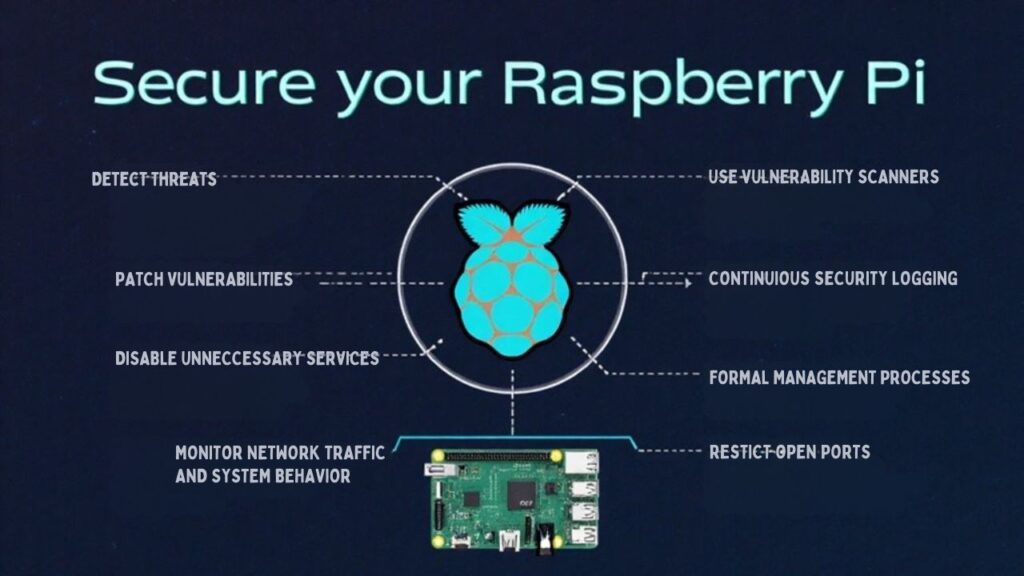
Although robust hardware defenses form the foundation of secure Raspberry Pi deployments in IoT, managing vulnerabilities and detecting threats requires an equally rigorous approach at the software and network layers.
IoT devices, including those based on Raspberry Pi, have become attractive targets for attackers due to their widespread use and often lax security practices, making IoT security vulnerabilities a critical concern for every deployment.
You need formal vulnerability management processes, including clear vulnerability reporting channels and regular use of vulnerability scanners like Nessus, to rapidly identify network-based flaws and missing patches.
Proactive security management of IoT devices using enterprise-grade solutions such as Microsoft Defender is essential for maintaining visibility, discovering vulnerabilities, and reducing risks within Raspberry Pi networks.
Disable unnecessary services and restrict open ports to reduce your attack surface. Incorporate automated software updates and cryptographically signed boot processes to maintain device integrity against code injection.
For effective anomaly detection, monitor network traffic and system behaviors, leveraging both device and enterprise IoT threat platforms for real-time alerts and custom threat hunting queries.
Continuous security logging guarantees rapid detection and forensic response to evolving threats targeting your Raspberry Pi IoT endpoints.
Ensuring Secure Communication Protocols

Because communication channels are prime targets for interception and manipulation in IoT environments, securing data transmission between your Raspberry Pi and other endpoints is vital. You should implement robust encryption protocols—using TLS for HTTPS and DTLS for MQTT guarantees secure transmission and data integrity. ETSI EN 303 645 recommends these secure communication standards to protect against data tampering and eavesdropping. SSHv2 with key-based authentication for remote access, combined with VPNs, adds an important layer of protection. Restrict SSH to specific IP addresses and employ non-standard ports for further resilience.
To enhance vigilance and maintain performance over time, regularly monitor performance metrics on the Raspberry Pi using tools like htop, which provides real-time CPU, memory, and process information. For device authentication, leverage digital certificates or EAP/RADIUS protocols to assure only authorized devices connect. Changing the default SSH password immediately significantly reduces the risk of unauthorized remote access to your Raspberry Pi in IoT deployments.
| Security Measure | Function |
|---|---|
| TLS/DTLS | Encrypts data for secure transmission |
| SSHv2 + Key Auth | Secures remote access |
| VPN | Enhances encryption protocols |
| Device Certificates | Guarantees device authentication |
Maintaining Software Update Integrity
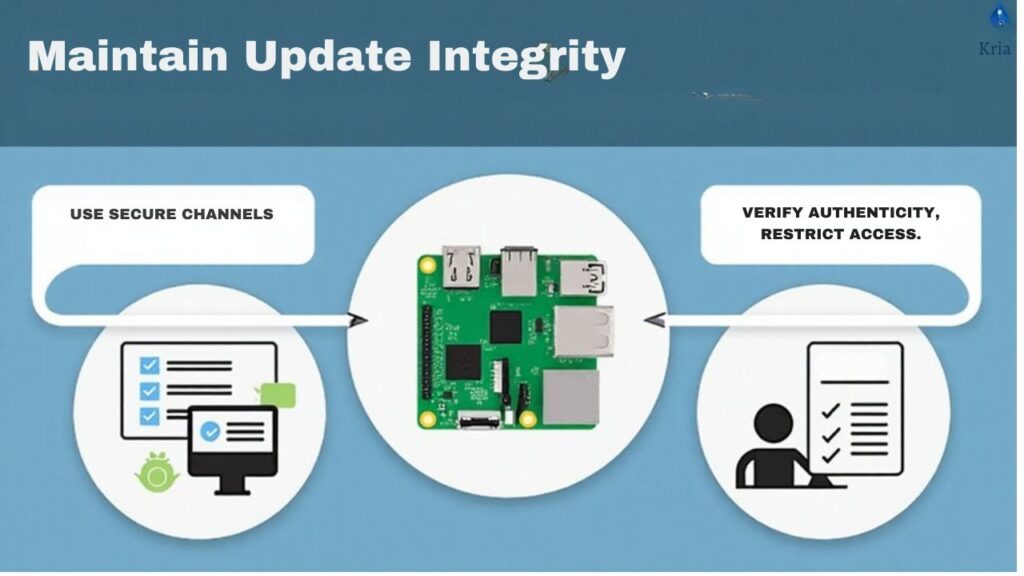
Ensuring the integrity of software updates on your Raspberry Pi is critical to maintaining a trustworthy and resilient IoT deployment.
You’ll want to implement a blend of transactional updates and robust package management to avoid the pitfalls of failed or compromised upgrades. Cleanly packaged dependencies reduce the chances of update conflicts and are essential for maintaining system stability as your IoT deployment grows. Many users are unaware that differences in Raspbian OS versions—such as those between pre-installed SD cards and downloadable images—can impact which commands, like rpi-update, are available and how updates are managed.
Prioritize strategies that deliver continuity and rollback options, minimizing downtime and risk.
- Leverage atomic, transactional updates: Dual-partition systems with image-based updates let you boot into a fully tested environment and roll back seamlessly if issues emerge.
- Refine package management practices: Build and deploy custom-debian packages, utilize regular `apt-get` updates, and schedule upgrades to maintain security patches without dependency conflicts.
- Automate with confidence: Employ tools like `unattended-upgrades` and conduct dry runs to verify that automated update flows don’t disrupt stability.
Consistent update integrity mitigates risks as your IoT footprint scales.
Meeting Regulatory and Compliance Requirements
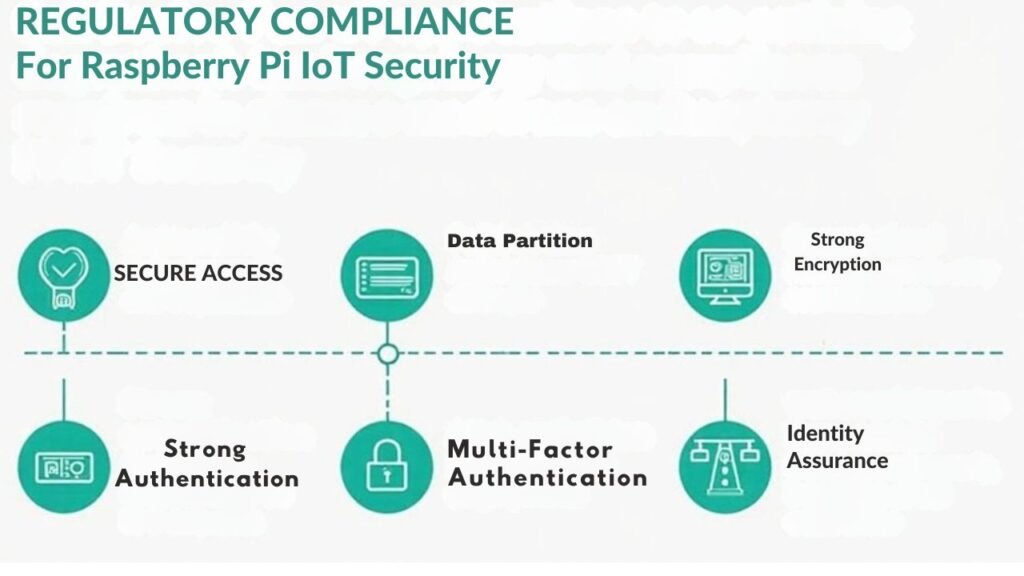
To meet regulatory and compliance requirements, you need to implement device authentication best practices, enforce mandatory patch management, and handle data securely at every stage. Many regulations now require hardware access control to protect against cyber and physical threats. If you overlook any of these areas, you risk non-compliance and increased exposure to cyber threats.
Focus on solutions that align with established standards to protect both your devices and user data. Regulatory frameworks such as GDPR highlight the importance of hardware security features to ensure data integrity and privacy in connected devices.
Device Authentication Best Practices
While IoT deployments increasingly attract cybersecurity scrutiny, robust device authentication on Raspberry Pi platforms remains essential to meet regulatory and compliance mandates.
To deliver strong identity assurance and compliance, you’ll need proven strategies like certificate provisioning and SSH hardening. Adopt Public Key Infrastructure (PKI) to facilitate unique device certificates and enforce mutual authentication on platforms such as AWS IoT or Azure IoT Hub. When using Raspberry Pi devices, layering multiple authentication factors—such as combining certificates with unique hardware identifiers or MAC addresses—significantly increases resistance to unauthorized device impersonation. Leveraging Azure IoT Hub integration will enable robust cloud-based authentication workflows for Raspberry Pi devices.
SSH key-based access eliminates password attack vectors and tightens control over administrative sessions. For leading-edge security and audit readiness:
- Use automated certificate provisioning and rotation to maintain valid cryptographic identity for regulatory adherence.
- Harden SSH by disabling default credentials, enforcing key pairs, and layering two-factor authentication.
- Secure private keys and certificate stores with strict permissions, auditing, and, preferably, hardware-backed modules.
Mandatory Patch Management
Beyond rigorous device authentication, you can’t ignore the operational reality of keeping Raspberry Pi IoT devices continuously protected against evolving threats.
Effective patch management strategies aren’t just a best practice—they’re often a regulatory mandate. Regularly deploying patches reduces liability and guarantees compliance with data protection, network security, and auditing standards. With the advent of live patching technology for Raspberry Pi, users can now apply critical kernel updates without disrupting system uptime, mirroring the security and ease of professional installations.
Regular updates are essential to mitigate security threats in IoT environments where even minor vulnerabilities can be exploited quickly.
Live patching benefits, such as those provided by KernelCare, allow you to apply essential security updates in real time, ensuring uninterrupted operation of critical infrastructure.
Leveraging tools like Ansible and Puppet, you can automate updates across distributed device fleets, achieving both efficiency and oversight.
Continuous monitoring and reporting are integral to demonstrating compliance and managing risk. Embrace automation and live patching to meet regulatory requirements while driving innovation and operational resilience.
Secure Data Handling
Although innovation often drives IoT adoption, you can’t afford to overlook the stringent data protection and cybersecurity regulations that underpin secure deployment of Raspberry Pi devices.
Regulatory frameworks like the PSTI Act, GDPR, and ETSI EN 303 645 mandate strict controls around data privacy and integrity. You’ll need to ascertain compliance by using industry-standard encryption, strong authentication, and continuous monitoring. Deploying Virtual Private Cloud (VPC) environments for Raspberry Pi-based IoT projects adds an additional layer of network isolation, helping to meet privacy mandates and reduce attack surfaces.
To further enhance protection, consider leveraging existing systems and libraries for security instead of custom cryptographic implementations, as this both streamlines compliance and significantly reduces vulnerabilities.
Secure data handling isn’t only about preventing breaches—it’s about designing resilient, compliant IoT solutions from the outset.
Focus on the following:
- Encrypt all sensitive data at rest and in transit, leveraging robust cryptographic libraries.
- Implement strong access controls, including RBAC and multi-factor authentication, to restrict unauthorized operations.
- Establish automated secure backups and audit trails to satisfy compliance, mitigate data loss, and ascertain forensic readiness.
Advanced Data Protection Strategies
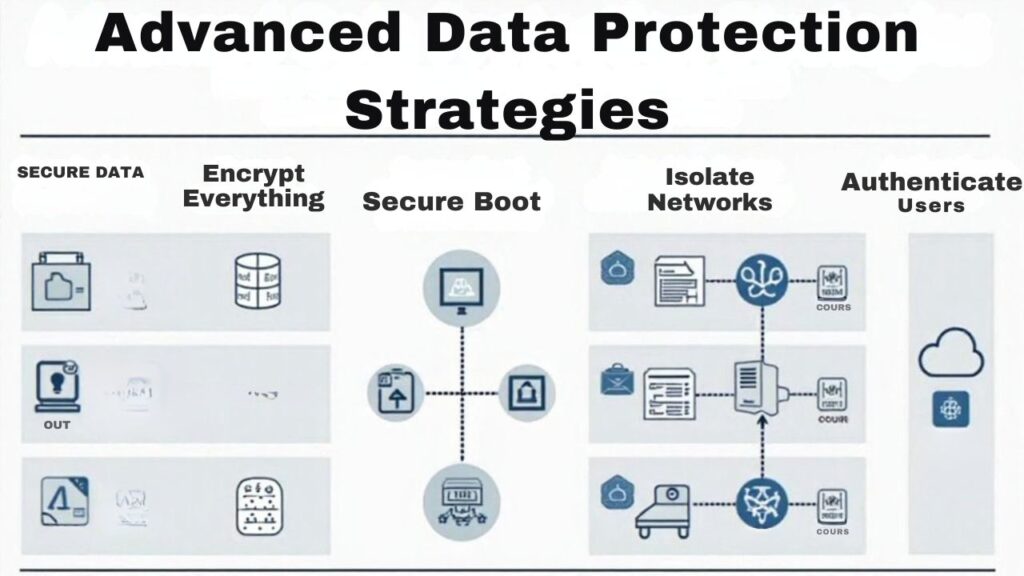
To strengthen your device’s data resilience, you should enable real-time disk encryption so that sensitive information remains protected even if the storage medium is physically accessed.
Implement secure boot to guarantee that only trusted, verified firmware and operating systems run on your Raspberry Pi, blocking persistent threats at startup.
By incorporating device authentication and access control, you add a critical layer of defense, ensuring that only authorized users and processes can interact with your IoT device.
These combined strategies guard against both software- and hardware-based attacks, making unauthorized data access considerably harder. Regularly conducting audits and risk assessments helps identify and address new vulnerabilities in your Raspberry Pi deployment.
Real-Time Disk Encryption
When securing a Raspberry Pi within an IoT deployment, real-time disk encryption forms a critical line of defense against data exposure from device theft or unauthorized access.
Leveraging tools like LUKS, cryptsetup, and VeraCrypt, you can guarantee that sensitive data remains protected, even if storage media falls into the wrong hands. Given the evolving nature of initramfs and /boot/firmware in newer Raspberry Pi OS versions, it’s important to adapt your encryption setup to remain compatible with current system boot processes.
A crucial starting point is implementing Raspberry Pi Imager imaging steps to ensure the operating system and storage are set up securely from the beginning.
However, you’ll need to strike a balance between robust encryption and ideal disk performance, especially in resource-constrained environments.
Consider these essential steps to drive an effective strategy:
- Confirm compatibility between your Raspberry Pi model, operating system, and your chosen real-time encryption tool.
- Integrate hardware acceleration and processor capabilities to minimize impacts on disk performance and maintain seamless IoT operations.
- Develop automated encryption management scripts and harness remote access features, such as Dropbear SSH, for resilient and scalable device management.
Secure Boot Implementation
While even robust disk encryption can’t prevent execution of unauthorized firmware, implementing Secure Boot raises your defense by guaranteeing only trusted, signed code runs during each Raspberry Pi startup.
You leverage cryptographic keys stored in OTP memory to enforce boot integrity, validating every bootloader and firmware component via RSA-based signature checks. By generating your signing keys on an offline device, you minimize key exposure risks and strengthen your chain of trust.
Enabling the SIGNED_BOOT=1 flag and programming irreversible OTP settings—like revoke_devkey—prevents downgrades, unsigned firmware, and hardware level attacks including unauthorized mass storage access.
Recovery.bin and robust firmware verification routines further guarantee memory architecture weaknesses can’t be exploited.
For advanced users, integrating solutions like wolfBoot or leveraging TPM support pushes your security posture even further.
Network Segmentation and Traffic Isolation
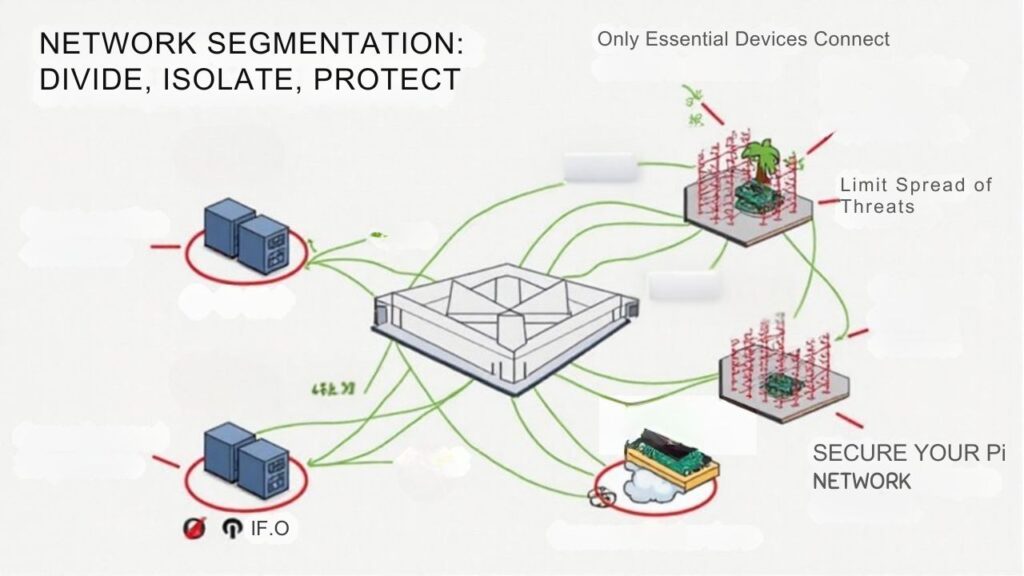
Although the flexibility of IoT networks invites rapid expansion, it also introduces significant security risks if devices remain interconnected without boundaries. To mitigate these threats, you must employ network isolation techniques and smart VLAN configuration strategies on your Raspberry Pi.
Unrestricted IoT networks grow fast but amplify security risks—network isolation and VLANs on your Raspberry Pi are essential defenses.
By segmenting IoT devices into distinct VLANs, you dramatically reduce lateral movement opportunities for attackers, tightening access to sensitive data. Equip your deployment with robust controls—for instance, enforce a zero-trust policy and configure firewalls to restrict cross-segment traffic.
Here’s how you can elevate security:
- Deploy VLANs to segment IoT devices and shield critical resources.
- Implement role-based access controls and use secure authentication protocols.
- Monitor segmented traffic in real time, ensuring anomalous activities are detected and addressed immediately.
This approach strengthens your IoT ecosystem’s resilience.
Frequently Asked Questions
Can Raspberry Pi Support Biometric Authentication in Iot Projects?
You can implement advanced authentication methods in your IoT projects using Raspberry Pi. By integrating biometric sensors—like fingerprint or facial recognition—you’ll achieve robust, innovative user authentication and streamline secure device access for your next-generation solutions.
How Can I Remotely Wipe or Disable a Compromised Raspberry Pi?
If you want to remotely wipe or disable a compromised Raspberry Pi, proactively deploy remote management tools and robust security protocols. Preconfigure emergency scripts, restrict network access, and automate responses, so you can instantly mitigate risks and minimize data loss.
What Are Best Practices for Securing GPIO Pins in Sensitive Applications?
Prioritize GPIO shielding to prevent electromagnetic interference and physical tampering. Restrict pin access using secure web interfaces and strict user permissions. Regularly audit connected devices, implement input validation, and actively monitor for unauthorized changes to maintain innovation and resilience.
How Do I Securely Decommission or Repurpose Old Raspberry Pi Devices?
When you securely decommission or repurpose old Raspberry Pi devices, prioritize data destruction with multi-pass wipes, physically destroy storage if needed, and document device recycling or reuse. Always revoke credentials and audit network references to minimize residual risk.
What Third-Party Hardware Tokens Are Compatible With Raspberry Pi for Authentication?
Imagine locking your digital doors with an iron key—YubiKey integration lets you do just that. You can embrace robust token authentication on Raspberry Pi using YubiKey hardware or custom Fidelio tokens, boosting both innovation and security.
Conclusion
If you ignore robust security for Raspberry Pi in your IoT deployment, you might as well roll out the red carpet for every hacker on the planet. But by implementing encrypted protocols, hardware security modules, strict patch management, and real-time monitoring, you’ll drive down risks to nearly zero. Always prioritize network segmentation and access controls, and you’ll outpace most attackers. Your proactive, layered approach isn’t just best practice—it’s mission critical to safeguard your IoT solutions.

I am a retired software engineer with experience in a multitude of areas including managing AWS and VMWare development environments. I bought a relative a mini-PC a year ago and have become passionate about the technology and its potential to change how we deploy software.

